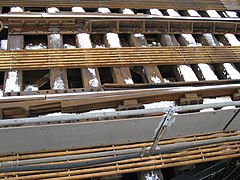Breather switch
A breather switch, expansion joint, or adjustment switch is an intentional gap in railway tracks to allow for thermal expansion in long sections of otherwise unbroken rail. They are placed between very long sections of continuous welded rail or at the transition from continuous welded rail to jointed track, and commonly in the vicinity of bridges, viaducts and tunnels where the infrastructure and track may expand at different rates.[1]
The mating sections are tapered diagonally (unlike a butt joint between two lengths of rail), allowing smoother transitions and higher speeds across the gap.[2]
Breather switches have two advantages over jointed track: they greatly reduce the small gap between the rails, eliminating or significantly reducing the noise and vibration caused by passing trains, and, where continuous welded rail is particularly prone to expansion, they act as relief points to ensure that track does not warp out of shape or result in a sun kink.[3]
References
[edit]- ^ Briginshaw, David (2016-03-08). "British university to build prototype switch". International Railway Journal. Retrieved 2023-02-13.
- ^ Kampczyk, Arkadiusz (2020-08-10). "Measurement of the Geometric Center of a Turnout for the Safety of Railway Infrastructure Using MMS and Total Station". Sensors. 20 (16): 4467. doi:10.3390/s20164467. ISSN 1424-8220. PMC 7472250. PMID 32785082.
- ^ Hoather, Ian; Mandal, Nirmal (May 2016). "Management of Rail Stress in a Modern Railway Maintenance Infrastructure". Researchgate.
External Websites
[edit]- Voestalpine Expansion switches
- Breather switches
- Expanding our understanding of the not so insignificant rail expansion joint
- Rail Structure interaction



